 Three titans of the advertising world were staring steadfastly at an audience of 250 professionals eager to absorb some wisdom at Advertising Week 2014. Their topic was “Clash of the Titans: When Big Data Met Big Creativity.” Of course, the three titans in question represented only “Big Creativity.” “Big Data” was either too frightened to attend or, more likely, wasn’t invited.
Three titans of the advertising world were staring steadfastly at an audience of 250 professionals eager to absorb some wisdom at Advertising Week 2014. Their topic was “Clash of the Titans: When Big Data Met Big Creativity.” Of course, the three titans in question represented only “Big Creativity.” “Big Data” was either too frightened to attend or, more likely, wasn’t invited.
Chuck Porter of CP+B, Khai Meng of Olgilvy & Mather, and Sir John Hegarty of Bartle, Bogle, Hegarty have made an impact on advertising and continue to do so. Each took time to display fresh creative feats that drove successful ad campaigns for clients. The only thing that was missing was a fresh perspective. Big data was presented as a nuisance that threatened to impede creativity. They don’t realize that Big Data is more likely to become marketing’s biggest ally than its mortal enemy.
The Old Guard View of Big Data is Negative
Chuck Porter led off with the insight he had divined from data by stating that people react to: cute children, cute animals, sexy people and suspense. He then pointed out, “Aristophanes knew that in 450 [sic] BC.” While it’s not clear these were actually part of the poetic comic’s repertoire, Porter succinctly summed up the sentiment in the room: “Everything that can be counted, doesn’t count. Everything that counts can’t be counted.” There was nary a mention of data having value.
Sir John Hegarty echoed this sentiment in a colorful way: Data > Big Data > Bad Data > Weather. The clear implication is that more data doesn’t necessarily provide better outcomes. The weather may be bad regardless of how much you know about it and your ability to predict it isn’t guaranteed by having more information. We can all relate to this metaphor.
We can also relate to some of the impressive television commercials his firm created that were not tested on focus groups. While he may have failed to consider that data most likely suggested which demographic to target and which concepts to highlight in those ads, he did cite data that appeared to validate the campaigns’ successes. It appears he didn’t think those figures should fit into the categories of “Bad Data” or “Weather.”
Data Can Provide Direction
 Marketers want to be successful. It’s not just about the art. Performance matters. The rise in data should be viewed as a benefit to marketers that can fuel creativity and results. Insights derived from consumer behavior can expose new creative concepts to explore. Performance data can indicate whether creative is being distributed properly and having the desired impact. With XAPP Ads, we are starting to see correlation between the way offers are expressed in radio ads and engagement rates. These insights can help great creative be more effective.
Marketers want to be successful. It’s not just about the art. Performance matters. The rise in data should be viewed as a benefit to marketers that can fuel creativity and results. Insights derived from consumer behavior can expose new creative concepts to explore. Performance data can indicate whether creative is being distributed properly and having the desired impact. With XAPP Ads, we are starting to see correlation between the way offers are expressed in radio ads and engagement rates. These insights can help great creative be more effective.
Similarly, consumer data can also help advertisers target beyond demographics to behaviors and intent. One of the big advantages of Internet Radio is greater knowledge about audience preferences than Broadcast Radio and the ability to reach specific audience members with certain advertising. Marketers are making a mistake if they are simply running traditional radio ads on Internet Radio. They should be exploiting the interactivity, targeting and measurement capabilities to improve ROI.
Data Provides Measurement
In June, we posted a framework for radio advertising engagement that included Motivation, Method and Measurement. Consumer motivation is driven by the creative. It is the front end of the cycle and is not about to be displaced by Big Data. However, data mined from the measurement phase of previous campaigns can help advertisers avoid traps and increase the chance of future success.
Sometimes there seems to be an unnatural fear of measurement. Maybe the concern is that measurement today is too often a blunt instrument. We focus on terms like “attribution” and “viewability” that focus on distribution and not effectiveness. Or maybe, effectiveness measures have historically been arbitrary. At a time when marketing is under pressure to justify the value of advertising spend, data can be the primary tool to show validated results and make adjustments when performance is not up to par.
Avoiding Wind Tunnel Marketing
 Hegarty rightly pointed out the risk of data-driven marketing when he discussed “Wind Tunnel” marketing. The term is derived from the time in history when all of the automakers started using wind tunnels as part of their design process. Unsurprisingly, wind tunnels delivered data about airflow efficiency that was consistent. The result? All of the new car models started to look alike. Marketers had abandoned a key tool for differentiation and data had walked them down a path to design commoditization.
Hegarty rightly pointed out the risk of data-driven marketing when he discussed “Wind Tunnel” marketing. The term is derived from the time in history when all of the automakers started using wind tunnels as part of their design process. Unsurprisingly, wind tunnels delivered data about airflow efficiency that was consistent. The result? All of the new car models started to look alike. Marketers had abandoned a key tool for differentiation and data had walked them down a path to design commoditization.
Data is not a Panacea, but it is a Powerful Tool
Mr. Hegarty’s “Wind Tunnel” concept makes an important point. Data is not a panacea. It can lead to counter-productive outcomes in an arena that benefits from differentiation and new ideas. If you aren’t careful, you can find bad data and bad ideas lying amongst your big data. However, data can also be a marketer’s closest ally. New measurement capabilities can remove ambiguity about whether advertising is effective or not. Successes can be unambiguously documented. Real-time measurement during an ad flight can offer an opportunity to double-down on the successful campaigns or adjust those that are underperforming.
The title of the Advertising Week panel was a bit disingenuous. It didn’t offer a comparative discussion, but it did achieve its objective – the venue was full. That’s some data the organizers can surely embrace. Next year, maybe the session will be “Romance of the Titans: How Big Creativity Fell in Love with Big Data.” If Big Creativity starts courting Big Data in 2015, we might see a romance that produces a new era of advertising innovation.
Related Posts
Unpacking the Data on Mobile Ad Effectiveness
The Data Piles Up – Radio Serves Ultramobile Listeners
Watch the XAPP Advertising Week Panel
